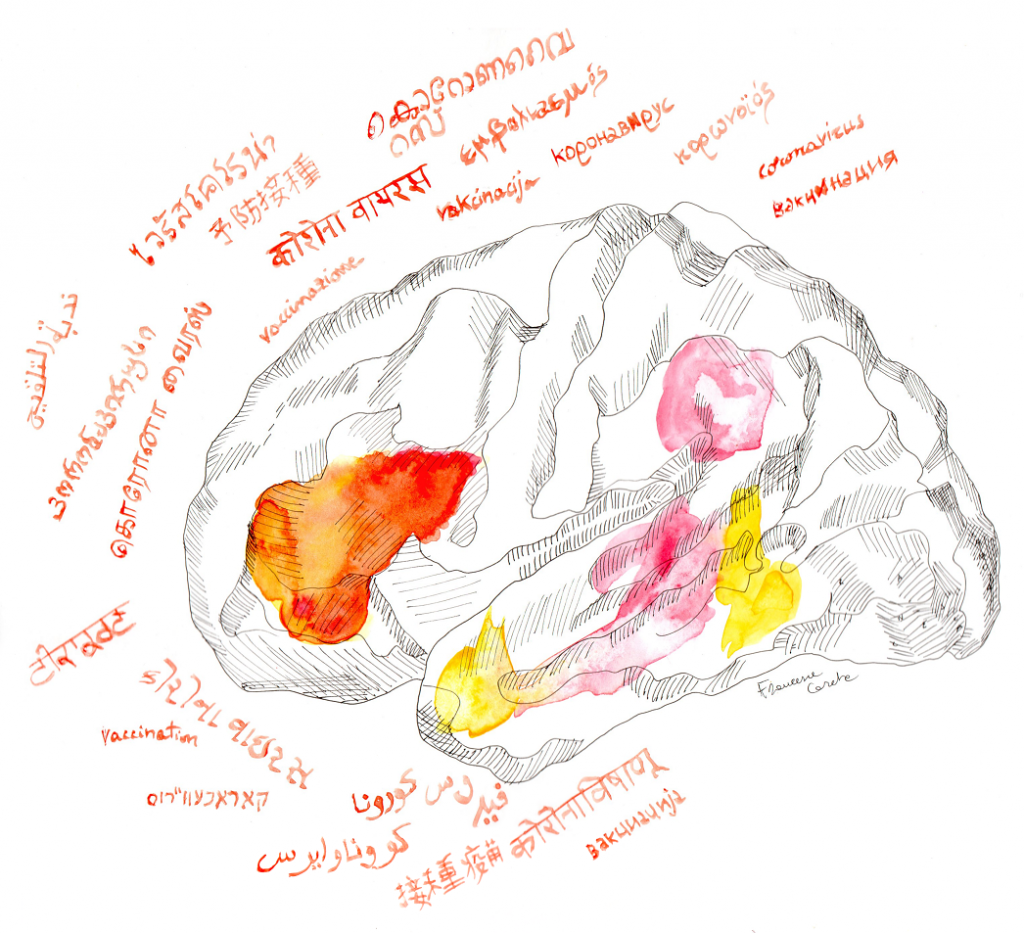“Changes are shifting outside the words”
Immediately after an invisible enemy was baptised as COrona VIrus Disease, or COVID-19, new Corona-related words sprung in languages all over the world: up to 700 in Dutch, and in German up to 1200 already. Why were so many words produced so quickly?
When we need to communicate challenging experiences, we may feel speechless, as the song’s chorus “the language is leaving me, … changes are shifting outside the words” expresses well. Somewhat similar, when confronted with a dramatic world change, our language system lacks the right words to express the unknown. In crisis, it self-reorganises to accelerate what it otherwise does constantly but much more slowly: creating new words. How does this happen?
Routes of language renewal
A quick route for language innovation is borrowing a fresh word from another language. In a world dominated by English, native speakers of Dutch, German, Italian, and so on, even though confined at home, talk about lockdown, droplets, contact tracing just because these words went… well, viral.
Besides, fun creative processes generate somewhat complex words, by playing with linguistic relations between meaning and structure within a language’s grammar. A very productive operation is to merge existing words to create a new item. In Dutch, Anderhalvemetersamenleving, for instance, means the society of social distancing, and consists of [anderhalve][meter][samenleving]/[one and a half][meter][society]. In German, CoronaFußgruß [corona foot greeting] indicates the new way of greeting each other despite forced physical distance, and coronamüde [corona sleepy/tired] being tired of Covid-19.
A more overlooked, but remarkably productive process constructs a word, like spreader, by combining the independent word spread with a grammatical element that modifies its meaning, like -er. An example from Italian is decretite (decreto, decree, and the element –ite meaning illness), the crazy tendency of the government to issue new decrees during the emergency. A retroscenista (from retroscena, background) is someone who suspects that something is going on behind the scenes of the pandemic like with backroom deals. More pragmatically, a vaccinista (from vaccino, vaccine) supports the vaccination campaign.
It is fascinating that some combinatorial operations can become unproductive. For example, native English speakers can still link warmth to the meaning of warm, but do no longer employ the element –th to produce new words. It can also be that words that were born combinatorially, like breadth and butterfly, do not relate to the meaning of existing words anymore (there is no butter in a butterfly), because their formant words are lost in language history. How can we handle these combinatorial processes?
Language combinatorics in the brain
To update our repertoire of available words we can count on an amazing engine: our brain. Different parts of the brain become allied to form and process new words. Neurons on the brain’s lateral sides store the meanings of concepts and fuel material for forging new words to the neurons in the brain’s left inferior frontal side. According to neurolinguists, this part lies at the heart of the capacity of language to combine a finite number of existing linguistic elements to generate new linguistic elements with potentially infinite meanings, like sentences. When we hear novel words formed by productive processes activity in this region increases. This means that, to learn and understand novel productive words like CoronaFußgruß and vaccinista the brain must segment their constituent elements. Reversely, when we hear unproductive combinatorial forms like warmth and butterfly, activity in this region decreases. This indicates that the more combinatorially unproductive a word is, the more the brain treats it as a simple, non-combinatorial word, like tree, or giraffe. Thus, the brain does an excellent job renewing our vocabulary.
In a time of isolation then, language renewal equipped us with new linguistic tools as social antibodies against the pandemic, to call new things by their name and make sense of them as part of a collective reality. Once the pandemic is over, language innovation will slow down, until our combinatorial brain will come to our rescue again in other times of change.
Read more
– Bozic M, Tyler LK, Ives DT, Randall B, Marslen-Wilson WD. 2010. Bi-hemispheric foundations for human speech comprehension. Proceedings of the National Academy of Sciences, U.S.A. 107: 17439-17444.
– Carota F, Bozic M, Marslen-Wilson, WD. 2016. Decompositional representation of morphological complexity: Multivariate fMRI evidence from Italian. Journal of Cognitive Neuroscience, 28, 1878e1896.
– Hagoort P, Indefrey P. 2014. The neurobiology of language beyond single words. Annual Review of Neuroscience 37: 347-362.
– Leminen A, Smolka E, Duñabeitia JA, Pliatsikas C. 2019. Morphological processing in the brain: The good (inflection), the bad (derivation) and the ugly (compounding). Cortex 116: 4-44.
– Marslen-Wilson WD, Tyler LK. 2007. Morphology, language and the brain: The decompositional substrate for language comprehension. Philosophical Transactions of the Royal Society: Biological Sciences 362: 823-836.
– Flood A. (November 2020). Oxford Dictionaries: 2020 has too many Words of the Year to name just one. The Guardian. Link
– Young-Power A. (March 2021). Coronaangst ridden? Overzoomed? Covid inspires 1,200 new German words. The Guardian. Link
– Ro C. (May 2020). Why we’ve created new language for coronavirus. Link
– Mahdawi A. From Covidiot to doomscrolling: how coronavirus is changing our language. Link
– Onkenhout P. De coronacrisis prikkelt het Nederlandse taalgevoel: al 700 nieuwe woorden. Interview Taalpublicist Ton Den Boon. De Volkskrant. Link
– Resources for new corona words: link, link, link
Pictures
– Header picture: Francesca Carota
Writer: Francesca Carota
Editors: Naomi Nota, Cecilia Hustá
Dutch translation: Inge Pasman
German translation: Fenja Schlag
Final editing: Merel Wolf

